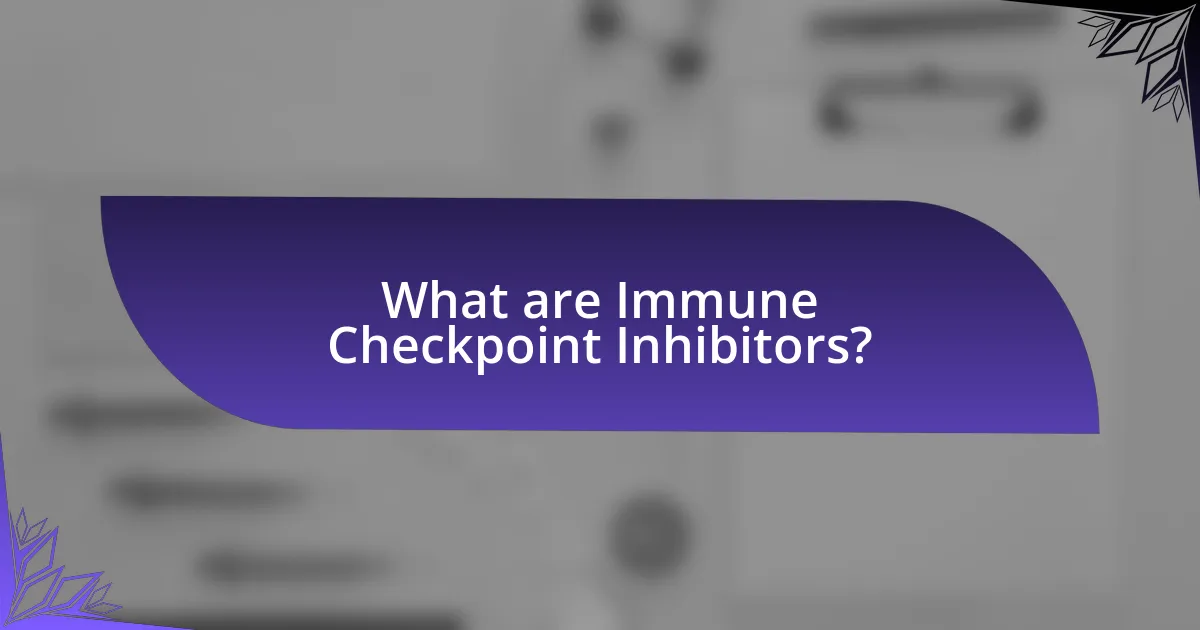Immune checkpoint inhibitors are a class of cancer therapies that enhance the immune system’s ability to combat tumors by blocking proteins that inhibit immune responses, specifically targeting checkpoints like PD-1, PD-L1, and CTLA-4. These inhibitors restore T-cell activity, leading to improved anti-tumor responses and significant survival benefits in various cancers, including melanoma and lung cancer. The article explores the mechanisms of action of these inhibitors, their applications in cancer treatment, the challenges associated with their use, and emerging therapies and targets in clinical trials. Additionally, it discusses the importance of personalized medicine and best practices for optimizing treatment outcomes with immune checkpoint inhibitors.

What are Immune Checkpoint Inhibitors?
Immune checkpoint inhibitors are a class of drugs that enhance the immune system’s ability to fight cancer by blocking proteins that inhibit immune responses. These inhibitors target specific checkpoints, such as PD-1, PD-L1, and CTLA-4, which cancer cells exploit to evade immune detection. By inhibiting these checkpoints, immune checkpoint inhibitors can restore T-cell activity against tumors, leading to improved anti-tumor responses. Clinical studies have demonstrated their effectiveness in various cancers, including melanoma and lung cancer, significantly improving patient survival rates.
How do Immune Checkpoint Inhibitors function in the immune system?
Immune checkpoint inhibitors function by blocking proteins that inhibit immune responses, thereby enhancing the immune system’s ability to attack cancer cells. These inhibitors target specific checkpoints, such as PD-1, PD-L1, and CTLA-4, which are mechanisms that tumors exploit to evade immune detection. By inhibiting these checkpoints, immune checkpoint inhibitors restore T-cell activation and proliferation, allowing the immune system to recognize and destroy cancer cells more effectively. Clinical studies have demonstrated that these therapies can lead to durable responses in various cancers, including melanoma and lung cancer, highlighting their significant role in cancer immunotherapy.
What are the key components of the immune checkpoint pathway?
The key components of the immune checkpoint pathway include immune checkpoint proteins, such as PD-1, PD-L1, CTLA-4, and their respective ligands. PD-1 (Programmed Cell Death Protein 1) is expressed on T cells and interacts with PD-L1 (Programmed Death-Ligand 1) on tumor cells, leading to T cell inhibition. CTLA-4 (Cytotoxic T-Lymphocyte-Associated Protein 4) competes with CD28 for binding to B7-1 and B7-2 on antigen-presenting cells, further downregulating T cell activation. These interactions are crucial for maintaining immune tolerance and preventing autoimmunity, but they can also be exploited by tumors to evade immune detection. The significance of these components is underscored by the success of immune checkpoint inhibitors in cancer therapy, which block these pathways to enhance anti-tumor immunity.
How do these components interact to regulate immune responses?
Immune checkpoint inhibitors interact with immune components by blocking inhibitory pathways that regulate immune responses, thereby enhancing T-cell activation and proliferation. These inhibitors, such as anti-CTLA-4 and anti-PD-1/PD-L1 antibodies, bind to their respective checkpoints on T-cells or tumor cells, preventing the downregulation of immune responses. For instance, CTLA-4 normally inhibits T-cell activation by competing with CD28 for binding to B7 molecules on antigen-presenting cells. By inhibiting CTLA-4, immune checkpoint inhibitors promote sustained T-cell activation, leading to a more robust immune response against tumors. Similarly, PD-1/PD-L1 interactions typically suppress T-cell activity in the tumor microenvironment; blocking this interaction allows T-cells to remain active and attack cancer cells. This mechanism has been validated in clinical studies, demonstrating improved survival rates in patients with various cancers treated with these inhibitors.
Why are Immune Checkpoint Inhibitors important in cancer therapy?
Immune checkpoint inhibitors are important in cancer therapy because they enhance the immune system’s ability to recognize and attack cancer cells. These therapies work by blocking proteins that inhibit immune responses, such as PD-1 and CTLA-4, thereby allowing T-cells to effectively target tumors. Clinical studies have demonstrated significant improvements in survival rates for various cancers, including melanoma and lung cancer, with immune checkpoint inhibitors leading to durable responses in a subset of patients. For instance, the use of pembrolizumab in melanoma has shown a 40% response rate, highlighting their critical role in modern oncology.
What role do they play in enhancing anti-tumor immunity?
Immune checkpoint inhibitors enhance anti-tumor immunity by blocking proteins that inhibit T-cell activation, thereby allowing the immune system to recognize and attack cancer cells more effectively. These inhibitors, such as anti-PD-1 and anti-CTLA-4 antibodies, disrupt the inhibitory signals that tumors use to evade immune detection. For instance, studies have shown that patients treated with anti-PD-1 therapies exhibit increased T-cell activity and improved tumor response rates, demonstrating the effectiveness of these agents in promoting anti-tumor immunity.
How do they differ from traditional cancer treatments?
Immune checkpoint inhibitors differ from traditional cancer treatments primarily in their mechanism of action; they enhance the body’s immune response against cancer cells rather than directly targeting the cancer cells themselves. Traditional treatments, such as chemotherapy and radiation, work by killing rapidly dividing cells, which can include both cancerous and healthy cells, leading to significant side effects. In contrast, immune checkpoint inhibitors, like pembrolizumab and nivolumab, block proteins that inhibit immune responses, allowing T-cells to recognize and attack cancer cells more effectively. This targeted approach can result in fewer side effects and potentially longer-lasting responses, as evidenced by studies showing improved survival rates in certain cancers, such as melanoma and lung cancer, when treated with these inhibitors compared to conventional therapies.

What are the different types of Immune Checkpoint Inhibitors?
The different types of immune checkpoint inhibitors include monoclonal antibodies that target specific checkpoints on immune cells. The primary categories are inhibitors of the programmed cell death protein 1 (PD-1), such as pembrolizumab and nivolumab, and inhibitors of the programmed cell death ligand 1 (PD-L1), including atezolizumab and durvalumab. Additionally, cytotoxic T-lymphocyte-associated protein 4 (CTLA-4) inhibitors, such as ipilimumab, are also significant. These inhibitors work by blocking the signals that suppress immune responses, thereby enhancing the body’s ability to fight cancer. The effectiveness of these inhibitors has been demonstrated in various clinical trials, leading to their approval for treating multiple cancer types.
What are the most commonly used Immune Checkpoint Inhibitors?
The most commonly used immune checkpoint inhibitors are Pembrolizumab, Nivolumab, Atezolizumab, and Durvalumab. Pembrolizumab and Nivolumab target the PD-1 receptor, while Atezolizumab and Durvalumab target the PD-L1 ligand. These inhibitors have been widely adopted in clinical practice for various cancers, including melanoma, lung cancer, and bladder cancer, demonstrating significant efficacy in improving patient outcomes. For instance, Pembrolizumab has shown a 44% overall response rate in melanoma patients, according to clinical trial data published in the New England Journal of Medicine.
How does Pembrolizumab work as an Immune Checkpoint Inhibitor?
Pembrolizumab works as an immune checkpoint inhibitor by blocking the PD-1 receptor on T cells, which enhances the immune response against cancer cells. This blockade prevents the interaction between PD-1 and its ligands, PD-L1 and PD-L2, which are often overexpressed on tumor cells to evade immune detection. By inhibiting this pathway, Pembrolizumab allows T cells to remain activated and proliferate, leading to increased tumor cell destruction. Clinical studies have demonstrated its efficacy in various cancers, including melanoma and non-small cell lung cancer, showing improved survival rates in patients treated with Pembrolizumab compared to those receiving standard therapies.
What is the mechanism of action of Nivolumab?
Nivolumab functions as an immune checkpoint inhibitor by blocking the programmed cell death protein 1 (PD-1) receptor on T cells. This blockade enhances T cell activation and proliferation, allowing the immune system to recognize and attack cancer cells more effectively. Clinical studies have demonstrated that Nivolumab significantly improves overall survival in various cancers, including melanoma and non-small cell lung cancer, by reactivating T cell responses that are often suppressed by tumor cells through PD-1 signaling.
What are the emerging Immune Checkpoint Inhibitors in clinical trials?
Emerging immune checkpoint inhibitors in clinical trials include agents such as ABBV-181, a monoclonal antibody targeting PD-1, and Atezolizumab, which inhibits PD-L1. These inhibitors are being evaluated for their efficacy in various cancers, including non-small cell lung cancer and melanoma. For instance, ABBV-181 has shown promising results in early-phase trials, demonstrating enhanced anti-tumor activity compared to existing therapies. Atezolizumab has been validated in multiple studies, including the IMpower series, which highlighted its effectiveness in improving overall survival rates in patients with advanced cancers.
Which new targets are being explored for Immune Checkpoint Inhibition?
New targets being explored for immune checkpoint inhibition include LAG-3 (Lymphocyte Activation Gene 3), TIGIT (T cell immunoreceptor with Ig and ITIM domains), and VISTA (V-domain Ig suppressor of T cell activation). Research indicates that LAG-3 plays a role in T cell regulation and can enhance anti-tumor immunity when inhibited. Studies have shown that blocking TIGIT can improve T cell activation and function, leading to better responses in cancer therapies. Additionally, VISTA has been identified as a negative regulator of immune responses, and its inhibition may provide therapeutic benefits in various cancers. These emerging targets are being investigated in clinical trials to assess their efficacy and safety in combination with existing therapies.
What potential advantages do these new inhibitors offer?
These new inhibitors offer enhanced efficacy in cancer treatment by specifically targeting immune checkpoints that regulate T-cell activation. This targeted approach can lead to improved anti-tumor responses, as evidenced by clinical trials showing increased survival rates in patients with various cancers, such as melanoma and lung cancer. Additionally, these inhibitors can potentially reduce the risk of tumor recurrence by promoting long-lasting immune memory, which is supported by studies indicating durable responses in a significant percentage of treated patients.

What are the applications of Immune Checkpoint Inhibitors?
Immune checkpoint inhibitors are primarily used in the treatment of various cancers, including melanoma, non-small cell lung cancer, renal cell carcinoma, and Hodgkin lymphoma. These therapies work by blocking proteins that inhibit immune responses, thereby enhancing the body’s ability to fight cancer. For instance, drugs like pembrolizumab and nivolumab target the PD-1 pathway, while ipilimumab targets CTLA-4, leading to improved survival rates in patients with advanced malignancies. Clinical trials have demonstrated that these inhibitors can lead to durable responses and long-term remission in a subset of patients, highlighting their significant role in oncology.
In which types of cancer are Immune Checkpoint Inhibitors most effective?
Immune Checkpoint Inhibitors are most effective in melanoma, non-small cell lung cancer (NSCLC), renal cell carcinoma, and Hodgkin lymphoma. These cancers have shown significant responses to therapies targeting immune checkpoints such as PD-1, PD-L1, and CTLA-4. For instance, studies have demonstrated that patients with advanced melanoma treated with pembrolizumab, a PD-1 inhibitor, have a response rate of approximately 40%. Similarly, nivolumab has shown a 20-30% response rate in NSCLC, highlighting the effectiveness of these inhibitors in specific cancer types.
How do they perform in melanoma treatment?
Immune checkpoint inhibitors perform significantly well in melanoma treatment, demonstrating improved survival rates and durable responses. Clinical trials have shown that drugs like pembrolizumab and nivolumab, which target the PD-1 pathway, lead to a 40-50% response rate in advanced melanoma patients, with some achieving long-term remission. Additionally, combination therapies, such as nivolumab with ipilimumab, have resulted in even higher response rates, exceeding 60%, according to studies published in journals like the New England Journal of Medicine. These findings underscore the effectiveness of immune checkpoint inhibitors in managing melanoma.
What is their efficacy in lung cancer therapy?
Immune checkpoint inhibitors demonstrate significant efficacy in lung cancer therapy, particularly in non-small cell lung cancer (NSCLC). Clinical trials have shown that these agents, such as pembrolizumab and nivolumab, can lead to improved overall survival rates and durable responses in patients with advanced stages of the disease. For instance, the KEYNOTE-024 trial reported a median overall survival of 30 months for patients treated with pembrolizumab compared to 14.9 months for those receiving chemotherapy. This evidence underscores the role of immune checkpoint inhibitors as a transformative approach in the management of lung cancer, enhancing the immune system’s ability to target and eliminate cancer cells.
What are the challenges and limitations of using Immune Checkpoint Inhibitors?
The challenges and limitations of using immune checkpoint inhibitors include variable patient response, immune-related adverse events, and high treatment costs. Variable patient response is evident as only a subset of patients benefit from these therapies, with response rates often ranging from 20% to 40% depending on the cancer type. Immune-related adverse events can lead to significant morbidity, affecting organs such as the skin, gastrointestinal tract, and endocrine system, which complicates treatment management. Additionally, the high cost of immune checkpoint inhibitors, often exceeding $100,000 per year, poses a financial burden on healthcare systems and patients, limiting accessibility and treatment options.
What are the common side effects associated with these therapies?
Common side effects associated with immune checkpoint inhibitors include fatigue, skin rash, diarrhea, and immune-related adverse events affecting organs such as the lungs, liver, and endocrine glands. These therapies can lead to inflammation in various body systems due to their mechanism of enhancing immune responses, which may inadvertently target healthy tissues. Clinical studies have documented these side effects, with reports indicating that approximately 60% of patients experience some form of immune-related adverse event during treatment.
How do patient-specific factors influence treatment outcomes?
Patient-specific factors significantly influence treatment outcomes by affecting the efficacy and safety of therapies, particularly in the context of immune checkpoint inhibitors. Factors such as genetic variations, tumor microenvironment, immune system status, and comorbidities can alter how a patient responds to treatment. For instance, studies have shown that specific genetic mutations in tumors can predict responsiveness to immune checkpoint inhibitors, with certain biomarkers like PD-L1 expression correlating with better outcomes. Additionally, the overall health and immune status of the patient can impact the ability to tolerate treatment and achieve optimal responses, as evidenced by research indicating that patients with robust immune profiles tend to have improved survival rates.
What future directions are being explored for Immune Checkpoint Inhibitors?
Future directions being explored for Immune Checkpoint Inhibitors (ICIs) include combination therapies, biomarker identification, and novel targets. Researchers are investigating the efficacy of combining ICIs with other treatment modalities, such as chemotherapy, targeted therapy, and radiation, to enhance therapeutic outcomes. Additionally, the identification of predictive biomarkers is crucial for selecting patients who are most likely to benefit from ICI therapy, as evidenced by studies showing that specific genetic and molecular profiles can correlate with treatment response. Furthermore, novel targets beyond the traditional PD-1/PD-L1 and CTLA-4 pathways are being explored, including LAG-3 and TIGIT, which may provide new avenues for enhancing immune responses against tumors.
How is combination therapy enhancing the effectiveness of Immune Checkpoint Inhibitors?
Combination therapy enhances the effectiveness of Immune Checkpoint Inhibitors (ICIs) by targeting multiple pathways involved in tumor immune evasion, thereby improving overall anti-tumor responses. For instance, combining ICIs with chemotherapy or targeted therapies can increase the infiltration of immune cells into tumors and promote a more robust immune response. Clinical studies have shown that such combinations can lead to higher response rates and improved survival outcomes in various cancers, including melanoma and lung cancer, as evidenced by trials demonstrating significant improvements in progression-free survival when ICIs are used alongside other therapeutic agents.
What role does personalized medicine play in the future of these therapies?
Personalized medicine will play a crucial role in the future of immune checkpoint inhibitor therapies by tailoring treatments to individual patient profiles, enhancing efficacy and minimizing adverse effects. This approach utilizes genetic, biomarker, and phenotypic information to identify which patients are most likely to respond to specific therapies, thereby improving treatment outcomes. For instance, studies have shown that patients with certain genetic mutations or specific tumor microenvironments are more responsive to immune checkpoint inhibitors, leading to better survival rates. By integrating personalized medicine into clinical practice, healthcare providers can optimize therapeutic strategies, ensuring that patients receive the most effective interventions based on their unique biological characteristics.
What best practices should be followed when using Immune Checkpoint Inhibitors?
Best practices when using Immune Checkpoint Inhibitors include thorough patient selection, monitoring for immune-related adverse events, and adhering to established dosing guidelines. Patient selection should involve assessing biomarkers such as PD-L1 expression and tumor mutational burden, which can predict response to therapy. Monitoring is crucial, as immune-related adverse events can occur in various organ systems, necessitating timely intervention. Adhering to dosing guidelines ensures optimal therapeutic outcomes while minimizing toxicity, as evidenced by clinical trial protocols that demonstrate improved survival rates when these practices are followed.



